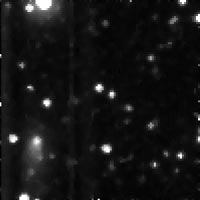Rosetta gets first glimpse of Deep Impact target

Comet 9P/Tempel 1 as seen from Rosetta
ESA’s Rosetta comet-chaser spacecraft has acquired its first view of the Deep Impact target, Comet 9P/Tempel 1.
This first Rosetta image of the Deep Impact campaign was taken by its Navigation Camera (NAVCAM) between 08:45 and 09:15 CEST on 28 June 2005.
The image shows that the spacecraft now points towards Comet 9P/Tempel 1 in the correct orientation. The NAVCAM is pointing purposely slightly off-target to give the best view to the science instrumentation.
The NAVCAM system on board Rosetta was activated for the first time on 25 July 2004. This system, comprising two separate independent camera units (for back-up), will help to navigate the spacecraft near the nucleus of Comet 67P/Churyumov-Gerasimenko in ten years time.
In the meantime though, the cameras can also be used to track other objects, such as Comet Tempel 1, and the two asteroids that Rosetta will be visiting during its long cruise, Steins and Lutetia.
The cameras perform both as star sensors and imaging cameras (but not with the same high resolution as some of its other instruments), and switch functions by means of a refocusing system in front of the first lens.
The magnitude of Comet Tempel 1 is at the detection limit of the camera: it is not as easily visible in the raw image and the image here is a composite of 20 exposures of 30 seconds each.
The comet is the fuzzy object with the tail in the lower left of the image. The faintest stars visible in this image are about 13th magnitude, the bright star in the upper left is about 8th magnitude. The image covers about 0.5 degrees square, and celestial north is to the right.
Media Contact
All latest news from the category: Physics and Astronomy
This area deals with the fundamental laws and building blocks of nature and how they interact, the properties and the behavior of matter, and research into space and time and their structures.
innovations-report provides in-depth reports and articles on subjects such as astrophysics, laser technologies, nuclear, quantum, particle and solid-state physics, nanotechnologies, planetary research and findings (Mars, Venus) and developments related to the Hubble Telescope.
Newest articles

Peptides on Interstellar Ice
A research team led by Dr Serge Krasnokutski from the Astrophysics Laboratory at the Max Planck Institute for Astronomy at the University of Jena had already demonstrated that simple peptides…

A new look at the consequences of light pollution
GAME 2024 begins its experiments in eight countries. Can artificial light at night harm marine algae and impair their important functions for coastal ecosystems? This year’s project of the training…

Silicon Carbide Innovation Alliance to drive industrial-scale semiconductor work
Known for its ability to withstand extreme environments and high voltages, silicon carbide (SiC) is a semiconducting material made up of silicon and carbon atoms arranged into crystals that is…





















